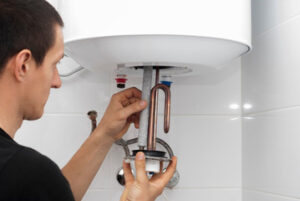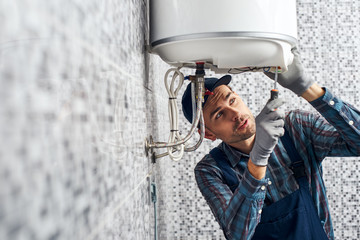Water heaters are complex appliances with many safety features. An improperly installed water heater can leak and explode, or cause carbon monoxide poisoning.

Before beginning work, read the printed installation instructions and all the safety warnings. Check the data plate to make sure the home’s voltage, wire sizes, and breaker are appropriate for this water heater. Click Here to learn more.
Many homeowners today are replacing old storage-type water heaters with new, more efficient models. While the job may seem simple enough, it’s important that you have the correct materials and tools on hand for a successful installation. This will help you to avoid problems resulting from incorrect materials, improper connections or non-compliant installations. In addition, you should follow all manufacturer’s instructions and local building codes when completing the project.
Unless your home is equipped with an open-water system, you’ll need to install a thermal expansion tank to prevent problems caused by pressure buildup. You also need to connect a temperature and pressure relief valve and a discharge line to the tank. This is to protect the water heater and the structure from damage if there is an over-pressurization problem.
For plumbing, you’ll need copper tubing or steel pipe to hook up the hot and cold water lines. You’ll also need to use compression fittings on all of the pipe connections. Depending on your plumbing system, you may want to use flexible metal connectors or PEX. If you choose to use PEX, you should review the manufacturer’s literature and watch a few YouTube videos before using it for the first time in your home.
Before beginning the installation, make sure that you have a drain to route the effluent from your new water heater. It is also a good idea to place the water heater in a drain pan to avoid any possible flooding. If the new water heater will be placed in an attic, it must be installed in a drain pan that is large enough to allow for a full evacuation of the water.
Regardless of whether you’re installing an electric or gas water heater, you should always have a fire extinguisher handy for any emergencies. You should also keep a fire blanket nearby to prevent the accidental ignition of any gas fumes.
If you’re working with an electric water heater, you’ll need to remove the cover from the junction box at the top of the unit. Using channel-lock pliers, disconnect the wires connected to the junction box and the cable clamp at the gas valve on the unit. Alternatively, you can buy a kit that comes with a manual-removable vent. This will allow you to remove the exhaust pipe without needing to remove the entire water heater.
Plumbing
If your water heater is old or nearing the end of its useful life, it’s time to replace it. But there are a few things you need to know before getting started.
First, decide what type of water heater to install or replace. There are two main types: traditional tank-style units that store and heat water, and tankless units that heat water on demand. The type of water heater you choose will dictate the plumbing materials and supplies you’ll need for the installation.
Once you’ve selected your new water heater, it’s important to hire a professional plumber to handle the installation. Do-it-yourself (DIY) water heater installations can lead to leaks, improper connections, and safety hazards. Plus, DIY installations can void the manufacturer’s warranty.
When a plumber handles your Water Heater installation, you can rest assured the job will be done correctly and safely. Plumbers have the tools and training to ensure your water heater is up to code and that all connections are secure. They can also help you select the right size water heater for your home.
Before any work begins, the plumber must shut off the water supply and gas to the unit. This will protect against property damage and serious injury. The water supply valve is typically located on the cold-water line above the water heater, while the gas valve is usually located on or around the unit.
A qualified plumber will also install a carbon monoxide detector, which is an important safety measure for households with gas water heaters. Carbon monoxide is a colorless and odorless gas that can build up in homes with hot water tanks. A CO detector will alert you to the presence of this deadly gas, allowing you to take action quickly.
Finally, your plumber will install an expansion tank, which is another important safety measure. Expansion tanks are designed to provide a relief outlet for the pressure that builds up in closed-circuit water heaters. Without this relief, the water heater can explode. Available in several sizes, expansion tanks are easy to install and will significantly reduce the risk of explosions caused by excess water pressure.
Electrical
For either a new water heater installation or replacing an existing one, you need various tools and supplies. These include torches & tanks, adjustable wrenches, wire brushes and tube cutting tools, hand saws and screwdriver sets, shims & wood shingles, dimensional lumber, electrical wire connectors and terminals, and more. In addition, you need to obtain any required permits and undergo inspections for a successful project.
Depending on the type of water heater you choose—tank-style or tankless—there are different requirements for electrical wiring and plumbing connections. The location where you plan to install the water heater also has an impact on the electrical requirements. For example, tank-style water heaters require a larger, more powerful electrical circuit than tankless units.
When working on an energized circuit, it is important to be extremely cautious and follow all safety instructions in the printed water heater owner’s manual. Failure to do so can result in property damage, serious injury or even death. To avoid this, shut off the circuit breaker that powers the water heater before starting any work. You should also drain the water heater, turn off the gas valve, and disconnect the water and power supply lines from the old unit.
In most cases, you can connect the water heater’s new wiring with the existing wiring by removing the cover on the junction box at the top of the unit and connecting like-colored wires with the help of a conduit connector. Afterward, you can lead the home’s bare copper or green ground wire to the water heater’s green ground screw.
If your water heater is a gas model, you must also disconnect the gas line from the gas control valve on the unit and use a pipe wrench to disconnect the draft hood from the vent pipe. A qualified installer will know how to handle these components and ensure they are properly installed and safely maintained.
In addition, professional installation helps you stay compliant with local codes and manufacturer’s warranties. A DIY installation could violate these warranties and lead to costly repair bills down the road. In short, hiring a plumber for a Water Heater installation is a smart choice that can save you money in the long run.
Venting
If you have a gas water heater, you’ll need proper ventilation for it. Without it, carbon monoxide, a colorless, odorless and deadly poison, could accumulate in your home. Proper venting also ensures combustion byproducts, such as exhaust, are safely vented outside. This is a non-negotiable aspect of water heater installation and should always be done by a professional.
The first step is to disconnect the existing gas line at the valve, using a pipe wrench or channel-lock pliers for compression or union fittings. Then, cut the water lines using a tubing cutter. If the pipes are copper, you should be able to reuse the water supply line and the temperature and pressure (T&P) relief valve—but don’t forget the plastic nipple! If you’re going to replace the vent piping, purchase new metal vent pipe. It must be rated the same size as the heater, and should have a double-chambered design to allow for both exhaust and fresh air.
Connect the new vent piping to the draft hood on top of the water heater. If the recommended diameter of the vent pipe is larger than the draft hood opening, you’ll need to install a reducer. Next, attach a new T&P valve. If your city requires it, you can add a sediment trap as well.
Aim the new vent pipe away from any windows, walls and other obstructions that could cause backdrafting—the reversal of the natural flow of exhaust gases and the dangerous accumulation of carbon monoxide in your home. You can test for backdrafting by closing all the doors and windows, and pointing an incense stick near the vent hood opening. The smoke should draw up into the hood, and not back down into your house.
If you’re replacing a gas water heater, check with the local building department to make sure you’ve got the right setup for your home. While do-it-yourself installations can save money, professional installation guarantees a safe, efficient and compliant set up that will last for years to come. It’s worth the investment in the long run to avoid expensive repairs and possible health hazards.

